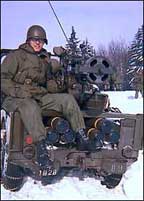 The Battle That Wasn’t
The Battle That Wasn’t
John K. Parmenter, Specialist 4 in the Mortar Section (81mm), Weapons Platoon, D Co, 1st Battle Group, 28th Inf (Black Lions of Cantigny), 1st Div.
The following article is based on Mr. Parmenter’s recollections.
22 OCT 62: Since early morning D Co, 1st Battle Group, 28th Inf, had been digging defensive positions in the Kansas dirt anticipating an assault by aggressors from fellow BRO units. This was the beginning of another of the endless field training exercises conducted by the 1st Div throughout the Cold War one more week in the field.
Prepared for several days of maneuver, the troopers were surprised when, at midmorning, an administrative convoy of empty 2½ ton trucks from one of Ft. Riley’s transportation outfits halted in their AO. Orders rang out and soon, loaded on deuce-and-a-halfs, D Co. trucked back to Black Lions’ Lair at Camp Forsyth.
Men, it looks like we’re about to get into an ass kicking contest, said the salty Delta Company CO, CPT Edward G. Passallaigue, to troops gathered in the company classroom. The pipe-smoking Passallaigue, an expert sky diver and tough professional soldier, had served an enlisted tour in the Korean War with the 187th Airborne Regimental Combat Team. He spoke of the intolerable missile threat in Cuba and the Commander-in-Chief’s determination to neutralize it. He then informed assembled infantrymen that plans were being developed for the 1st Div, among other forces, to assault Castro’s island. Without ceremony Delta Co. was ordered to prepare for deployment. Mimeographed packing lists were distributed and soldiers went to work.
In October 1962, most BRO troopers had been training with the division for over a year (since the 1961 Berlin Crisis elevated the 1st Div to full TO&E strength). Living their motto, No mission too difficult, No sacrifice too great, Duty first! they’d shed blood, sweat and tears on Ft. Riley’s abundant ranges and infinite hills. All division infantry had trained in the Colorado mountains. Early in ’62, the Black Lions, along with the 1st Recon Squadron, 4th Cav, 2nd Howitzer Bn., 33rd FA and other BRO units maneuvered on the desert of California. Young soldiers of the 1st Div considered themselves seasoned physically fit, skilled with weapons, drilled in tactics and masters of field craft. Several 1st Div battle groups, including 1/28, had recently undergone the U.S. Navy/Marine Corps amphibious assault course at Little Creek, Virginia learning skills useful in a Cuban invasion. Leadership in the BRO was exceptional. Senior officers (like 1/28 CO, COL Lloyd Haines) and NCOs were veterans of the Korean Conflict and WWII. Junior leaders were graduates of Ranger, Airborne, and other demanding courses. With absolute confidence in themselves, their training and their leaders, another generation of 1st Div soldiers prepared for battle.
Although confined to quarters, morale in CPT Passallaigue’s company soared. This was the real deal, not just another week in the field. Weapons, uniforms and equipment were cleaned, repaired, inspected, cleaned again and packed. Trucks and trailers parked in the company area were loaded with crew served weapons, ammunition and gear necessary to sustain a rifle company in combat. Bayonets were issued and men slept in shifts, dressed and expecting to be awakened with the order to move out. Soldiers listened to commercial radio and exchanged rumors. They learned the division’s advance party, 121st Signal Bn, had deployed to Florida and was establishing communications for the upcoming invasion. They listened intently as missile-loaded Soviet cargo ships approached U.S. pickets and cheered-on the brave American sailors. Some people spoke of earning the CIB and wearing the 1st Div patches on their right sleeves. Those in the know said USAF planes were landing at bases near Salina and Topeka prepared to fly the BRO to forward positions in Florida and that division armor and artillery was loaded on rail cars at Camp Funston. During the Cuban Missile Crisis, the 1st Div was at the highest state of readiness possible for a combat unit in the middle of the continental U.S. Packed, loaded and with transport standing by, all that was necessary was to mount up and head Southeast.
Like a tightly compressed giant spring, ever mindful of its magnificent heritage, the BRO awaited orders to engage America’s enemies.
Fortunately for mankind, world leaders in Washington and Moscow were able to resolve this international dispute without resorting to armed conflict. For D Co., 1st Battle Gp, 28th Inf, 1st Div the Cuban Missile Crisis ended not with a (nuclear) bang but with a nondescript order. Perhaps it was said best by weapons platoon SGT Richard Thurston: The war must be over, we’re going back to the field.
ATTENTION READERS
We See The World From All Sides and Want YOU To Be Fully InformedIn fact, intentional disinformation is a disgraceful scourge in media today. So to assuage any possible errant incorrect information posted herein, we strongly encourage you to seek corroboration from other non-VT sources before forming an educated opinion.
About VT - Policies & Disclosures - Comment Policy



